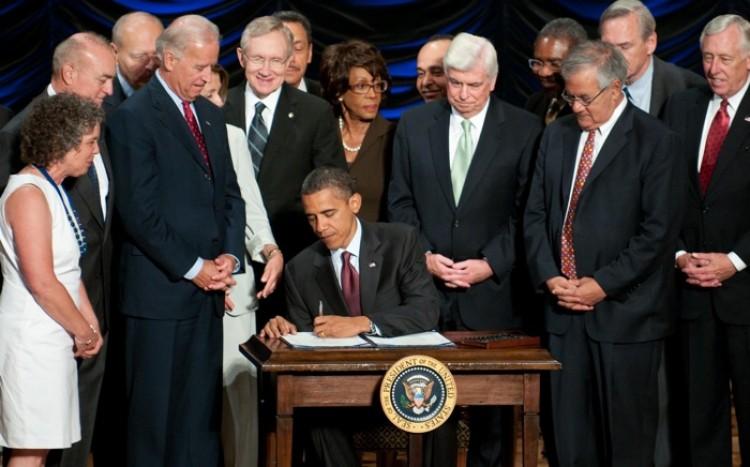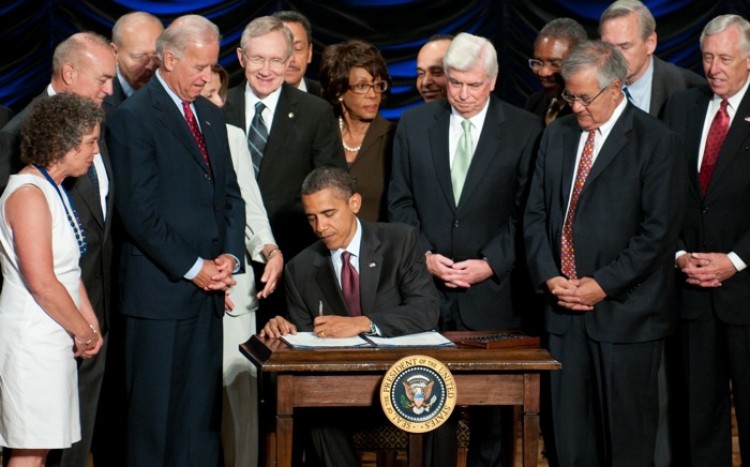President Abraham Lincoln enacted the first banking regulation in 1863. In response to bank failures during the Great Depression, the Federal Deposit Insurance Corporation (FDIC) was established as a temporary agency under the Banking Act of 1935 (also known as the Glass-Steagall Act) and became a permanent agency in 1935.
The FDIC’s mission, as described on their website, is that it “preserves and promotes public confidence in the U.S. financial system by insuring deposits in banks and thrift institutions for at least $250,000.”
FDIC insurance applies to all banks that operate legally in the United States, with the exception of international banks. Most likely a foreign bank operating in the United States is subject to similar laws in its home country, and thus its depositors are covered to a certain amount should the bank go under.
In Canada, the Canada Deposit Insurance Corporation (CDIC) insures deposits at charter banks. The CDIC is similar to the FDIC, but only insures deposits up to $100,000 Canadian. But not all Canadian charter banks are insured. Deposits at credit unions and branches of foreign banks are not insured. The CDIC website provides a list of insured banks.
The French Fonds de Garantie des Depots insures up to 70,000 euros (on June 15, one euro equaled US$1.4220). Germany has four different agencies that cover private, public sector, co-operative or savings banks and insures deposits up to 50,000 euros. Sweden insures deposits of up to 500,000 Swedish Krona (SEK) (on June 15, one SEK equaled US$0.1560). A few countries that insure up to 100,000 euros are the Netherlands, Portugal, and Spain. Italy insures a smidgen more than 100,000 euros.
Although there are European countries that have a deposit insurance agency, it is prudent to research a bank before depositing funds in such banks. The International Association of Deposit Insurers published a list of countries that enacted deposit insurance and the amounts insured.
“It pays to do some research about banking laws in foreign countries when investing in foreign banks that aren’t covered by the FDIC,” advises an article on the eHow money website.
An Abundance of Failing US Banks
Between 1930 and 1933, the time of the Great Depression, over 9,000 U.S. banks failed, mainly due to a run on banks, when panicked customers ran to the bank to withdraw their money. Banks ran out of cash, and a liquidity crisis ensued with many banks going under.
From 1934 to 1979, 562 banks failed in the United States, with an average of 12 bank failures per year. Actually, 390 banks failed between 1934 and 1942, and during the following 36 years, the average annual bank failure was at four banks, according to the Dave Manuel website.
Banks were deregulated under the Depository Institutions Deregulation and Monetary Control Act of 1980. Experts claim that full banking deregulation brings with it banking failures. However, selected deregulation could also bring benefits.
“We can expect deregulation to have had large effects on the real economy only if there were important changes in the structure and efficiency of the banking industry resulting from the reforms,” according to a 2003 research paper titled “The Real Effects of U.S. Banking Deregulation.”
Starting with 1981, 40 banks failed, which then jumped to 119 failed banks in 1982. Between 1988 and 1990, 1,386 banks failed. In response, regulatory changes of the banking sector was considered or enacted during every congressional session during the 1990s. Bank failures leveled off to less than 10 banks a year for most of those years until 2008.
In 1994, the deregulation of restrictions on opening branches allowed entry into new markets. But the aforementioned research paper concluded, “Banking deregulation of restrictions on branching and interstate banking lifted a set of constraints that had prevented better-run banks from gaining ground over their less-efficient rivals.”
The researcher found that after the 1994 deregulation, banks acquired smaller banks, consolidated into other banks, moved across state borders, and smaller banks lost ground.
“The financial crisis of 2007-08 has taught us that the confidence of the financial market, once shattered, can’t be quickly restored. In an interconnected world, a seeming liquidity crisis can very quickly turn into a solvency crisis for financial institutions,” stated an entry on the Investopedia website.
The 2007 to 2009 economic upheaval brought with it 177 bank failures. With the financial crisis not over, 157 banks failed in 2010, and since beginning of this year until June 3, another 45 banks failed, according to the FDIC failed bank list.
In response to bank failures, the public and experts demanded new banking regulation, envisioned to prevent banks from taking excessive risks with its customers’ deposits. But the result of such market intervention will only be known down the road.
Historical Snapshot Blazes Way for Future
“Rather than setting up one, large national bank as other countries do, the U.S. federal
government rolled out various laws in 1784 to encourage multiple banks in individual states,” stated a 2011 Knowledge@Wharton (KW) article.
Looking to increase taxable income, the U.S. government enacted a banking act in 1863 that advanced creation of smaller state banks. The government was looking for ways to fill its coffers, and one way was to create new banks that could be taxed.
In 1933, there were approximately 30,000 different kinds of banks and 14,146 commercial banks in the United States. With failed banks, consolidations, and mergers, by Dec. 31, 2010, less than half of those commercial banks were left in the United States. There were only 6,529 commercial banks, 82,641 branches, and 1,128 savings institutions, according to the FDIC website.
Very few banks have been set up over the years. In 1990, 163 new commercial banks were established, while 389 commercial banks merged into other banks, a smidgen when compared to the existing 12,343 commercial banks at that time.
Between 1991 and 2009, around 2,398 new commercial bank licenses were granted, while 7,481 banks merged into other banks, not requiring a new bank license. Actually, by the third quarter of 2010, only six new commercial bank charters were granted. A bank charter authorizes a bank to legally open doors.
It should not come as a surprise that 2,732 banks, more than 41 percent of the existing banks, opened doors 10 decades ago, while an equally large number has been around for several decades.
“With so many banks leaving the [banking] sector and so few entering it, a long-anticipated consolidation process is now under way,” stated the KW article.
KW suggests that banking consolidation will continue. However, today’s consolidations are not driven by merger and acquisition activities, but through bank failure. The FDIC will continue to arrange for failed banks to merge into other banks instead of closing the doors permanently.
“Many experts expect consolidation to continue, and predict that the trend will leave the banking system better off in the long run,” according to the KW article.
Next...Struggling to Fix Banking Sector
Struggling to Fix Banking Sector
“The basic problem is that the financial sector can hire the best, most talented people. It can pay them extraordinary amounts of money. They will always get ahead of the regulators,” said Simon Johnson, former International Monetary Fund chief economist, in a 2009 article on National Public Radio’s website.
This is mid-2011 and confidence in banks and as well as in the ability by the U.S. regulatory agencies to fix the banks is at an all-time low. The debate as to whether any bank should be considered too big to fail is still going strong, and the public demands that taxpayer funds should not bail out banks.
The concern expressed is that savvy people in the banking industry can skirt any regulation the regulators come up with, and not necessarily illegally, and be miles ahead of the game.
“The most basic point is simply that regulation always fails—companies always find a way around it,” James Kwak said on his blog when discussing a 2010 op-ed column by economist and Nobel Prize winner Paul Krugman.
A 2010 article on The Daily Reckoning website also dissected a Paul Krugman article and was rather cynical about government regulation being of value: “By nature, banks, like any other company, always find ways to grotesquely contort themselves around regulation. Extending ‘old-fashioned bank regulation’ is unlikely to help.”
Most experts agree that well-balanced regulation and contained risk taking by banks would go a long way in re-establishing confidence in the banking sector and the U.S. regulatory agencies.
International bank regulations have come into effect over the past years that also apply to U.S. banks doing business abroad. The Basel Committee was formed in 1974. It set up credit risk standards with Basel I, which was expanded by Basel II in 2004. Basel III is another modification in response to the latest financial crisis, meant to alleviate bank risk. With Basel III, the committee attempted to integrate its standards with national regulations. But implementation is a few years off, with deadlines ranging from 2013 to 2018.
Another way to fix the banking sector through regulation is the U.S. Dodd-Frank Wall Street Reform and Consumer Protection Act, signed into law by President Barack Obama on July 21, 2010.
Given the opinions shared by the public through the media, taxpayers are confused and somewhat unsure as to what is unfolding and how much the Dodd-Frank Wall Street Reform and Consumer Protection Act will truly fix the banking sector’s risk taking.
In mid-2011, the FDIC approved a draft rule, based on a Dodd-Frank requirement, which would require banks to regularly submit living wills, also called regulators resolution plan, detailing the firm’s credit exposure and thus giving an early warning of possible insolvency.
“The ability to plan in advance for the orderly resolution of a systemic entity is key to ending Too Big To Fail. ... These plans will be instructive to institutions as a way for them [the banks] to better understand how their business lines interact and how to mitigate the effects of failure risk. The plans also will help inform the FDIC on how to lessen the systemic ripple effects in the event one of these companies must be resolved under the new Orderly Liquidation Authority,” FDIC Chairman Sheila C. Bair said in a recent press release.





